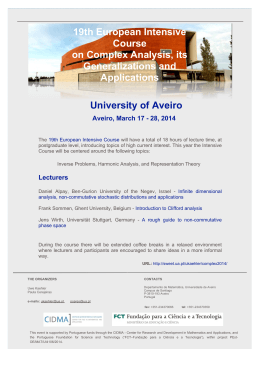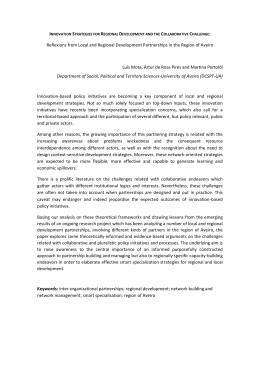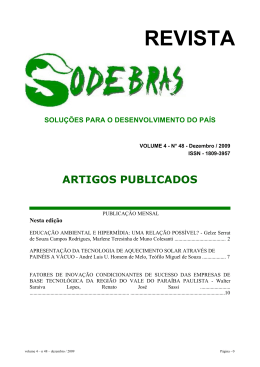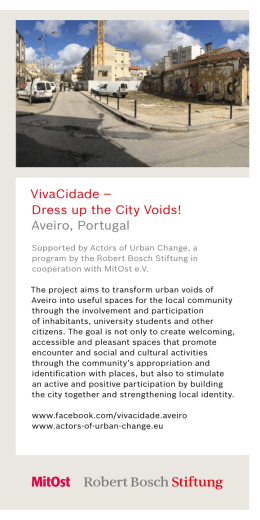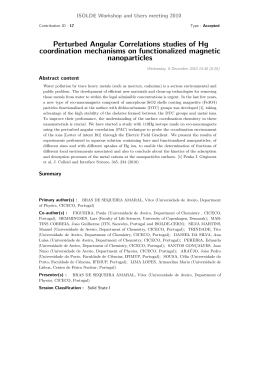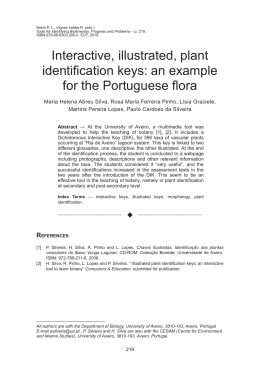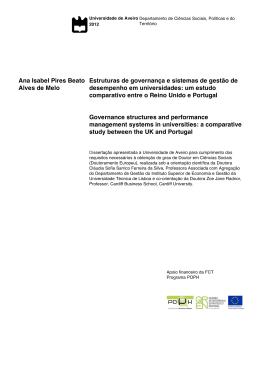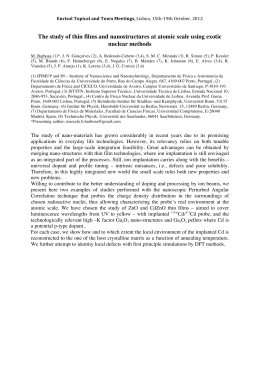Tecnologias da Informação em Educação Tracing the use of Communication Technologies in Portuguese Higher Education towards teachers’ professional development Marta Pinto University of Aveiro [email protected] Fernanda Nogueira University of Aveiro [email protected] Dalila Coelho University of Aveiro [email protected] Ana Balula University of Aveiro [email protected] António Moreira University of Aveiro [email protected] Abstract Aiming to characterize the way Portuguese Public Higher Education Institutions use Communication Technologies (CTs), the on-going project at University of Aveiro TRACER will apply a national online survey, therefore developing a prior pilot-study undertaken with validation purposes. This paper describes and summarizes part of the work developed within the pilot-survey, which includes a theoretical review outlining the context of CTs use and its impact on teacher training. First results of the pilot-study, which included four institutions, will be used to present institutional perspectives about CT use. The responses cannot be generalized as wide-reaching statements, but they already reveal that higher education institutions are making an effort to bring together policies and practices. Also, there seems to be a common awareness and concern about teacher training in this area, although training main topics and modalities seem to vary significantly. Results show that despite the uneven CIDTFF - Indagatio Didactica - Universidade de Aveiro Tecnologias da Informação em Educação Indagatio Didactica, vol. 5(4), dezembro 2013 ISSN: 1647-3582 spread of responses about the existence of a formal political strategy concerning CT, there is an institutional investment (currently and foreseen in a near future) on CTs, namely on teacher training for CTs use. Key Words: Communication Technologies; Higher Education; Teacher training; Professional development. Resumo Com o objetivo de caracterizar o uso das Tecnologias de Comunicação (TC) pelas instituições de Ensino Superior Público Português, o projeto em curso, TRACER, na Universidade de Aveiro irá aplicar um questionário online a nível nacional, validade por um estudo-piloto realizado. Este artigo descreve e resume o trabalho desenvolvido no âmbito do estudo-piloto, incluindo uma revisão teórica que define o contexto de uso das TC e seu impacto na formação de professores. Os primeiros resultados do estudo-piloto incluem quatro instituições para representar a perspetiva institucional sobre o uso das TC. As respostas não podem ser generalizados, mas revelam o esforço das instituições de Ensino Superior, para reunir políticas e práticas. Além disso, parece haver uma consciência e preocupações comuns com a formação de professores nesta área, embora as modalidades e temas principais da formação variem significativamente. Os resultados mostram que, apesar da distribuição desigual de respostas sobre a existência de uma estratégia política formal sobre uso e integração das TC, há um investimento institucional (atualmente e previsto num futuro próximo) em TC, nomeadamente na formação de professores para o seu uso. Palavras chave: Tecnologias da Comunicação; Ensino Superior; Formação de professores; Desenvolvimento profissional Resumen Con el objetivo de caracterizar el uso de Tecnologías de la Comunicación (TC) por las instituciones de Educación Superior Pública Portuguesa, el proyecto en curso, Tracer, de la Universidad de Aveiro pondrá en marcha una encuesta nacional en línea, la validez de un estudio piloto. En este artículo se describe y resume el trabajo realizado en el estudio piloto, incluyendo una revisión de la literatura que fija las condiciones para el uso de la TC y su impacto en la formación del profesorado. Los primeros resultados del estudio piloto, incluyen cuatro instituciones representan CIDTFF - Indagatio Didactica - Universidade de Aveiro 75 Tecnologias da Informação em Educação Indagatio Didactica, vol. 5(4), dezembro 2013 ISSN: 1647-3582 el punto de vista institucional sobre el uso de la TC. Las respuestas no se pueden generalizar, sino que revelan los esfuerzos de las instituciones de educación superior para cumplir con las políticas y las prácticas. Por otra parte, no parece haber una conciencia común y la preocupación por la formación del profesorado en este ámbito, a pesar de que los principales temas y modalidades de la formación varía considerablemente. Los resultados muestran que pese la desigual distribución de las respuestas en la existencia de una estrategia política formal sobre el uso e integración de TC, hay una inversión institucional (y actualmente planeado en un futuro cercano) en la TC, sobre todo en la formación del profesorado para su uso. Palavras clave: Tecnologías de la Comunicación; Educación Superior; Formación del profesorado; Desarrollo profesional 1. Introduction Over the last decade we have experienced an exponential increase in the use of Communication Technologies (CTs) in the different education levels. In Europe, CTs have shifted into more ubiquitous features, demanding from Higher Education Institutions (HEIs) a variety of technological services (Urry, 2002). Their use also increased as a result of the Bologna recommendations towards a rise in students’ autonomous work, processes that tend to be enhanced by the use of CTs. HEIs’ rapid evolution regarding their access to broadband Internet made it possible to offer the educational community different software, tools and environments that support a more networked, participatory web, empowering the user to distribute content and customize Internet applications (OECD, 2007). Consequently, the use of CTs is at the core of many changes in education in the last two decades. As to evidence of CTs ubiquity in HEIs, research concerning its use in teaching practices embraces different perspectives. Several emphasize that the use of CTs is not potentiating innovation or disruptiveness of more traditional forms of teaching, while others argue that disruptiveness is happening and leading to changes in the way teachers and students work, adopting new roles, in new learning environments (Bielaczyc & Blake, 2006; Garrison & Anderson, 2003; Wang, 2006). Moreover, research emphasizes the strengthening of teacher training as a key element for the enhancement of competences regarding current and emerging CTs and their effective integration into teaching practices (Conole & Alevizou, 2010; Herrington, Mantei, Herrington, Olney, & Ferry, 2008; JISC, 2009). The assumption that “technology alone does nothing to enhance pedagogy” CIDTFF - Indagatio Didactica - Universidade de Aveiro 76 Tecnologias da Informação em Educação Indagatio Didactica, vol. 5(4), dezembro 2013 ISSN: 1647-3582 (Georgina & Olson, 2007, 8) justifies the relevance of the present paper, aiming to provide up-to-date knowledge on Portuguese Public Higher Education Institutions (PPHEI) through an analysis of the institutional perspective of CT uses. Understanding the institutional infrastructures available for teaching practices and the mechanism in which teacher training is supported is crucial for the future of HEI, considering that the literature review reveals that effectiveness of teacher practices depends on the quality of the structures and mechanisms designed to support it, as well as of the human and technological resources available to attain its objectives. This paper focuses on the preliminary results of a pilot survey conducted in the scope of the project “TRACER – Portuguese Public Higher Education Use of Communication Technologies”1, on-going at the University of Aveiro. TRACER aims to contribute towards a large-scale and comprehensive study in Portugal, which will allow characterizing HEIs according to their adoption and use of CTs in formal educational contexts. The data collected within this project will be presented through an online interactive Information Visualization tool, whose ultimate goal is to contribute towards valuable and up-to-date information concerning the use of CTs in HEIs, potentiating research that may support actual innovation towards a new stage of technology-enhanced teaching and learning practices. The remaining paper is divided into the following sections: section 2 presents the theoretical framework regarding the use of CTs in HEI and some considerations about the need for teacher training; section 3, presents the description of the TRACER project is put forward as well as the methodology used in the pilot survey; section 4 presents the pilot survey main results are then presented followed by their discussion; section 5, the conclusions and final remarks. 2. Theoretical framework 2.1. The use of Communication Technologies in Higher Education Institutions CTs are revolutionizing the way individuals interact, create and build knowledge, share information and relate to each other. CTs are now embedded in people’s lives, in everyday work of educational institutions both at administrative and educational levels, shifting their lives into more ubiquitous and networked participation (Conole & Alevizou, 2010; Katz, 2008; OECD, 2007). In this article CTs are defined as the Internet supported hardware and software that allow and promote communication and 1 For further information visit http://cms.ua.pt/TRACER/ CIDTFF - Indagatio Didactica - Universidade de Aveiro 77 Tecnologias da Informação em Educação Indagatio Didactica, vol. 5(4), dezembro 2013 ISSN: 1647-3582 information distribution (Armstrong & Franklin, 2008; Grodecka, Wild, & Kieslinger, 2009). This is having impact and is estimated to further contribute towards the future of economy, society and personal quality of life (Urry, 2002). In order to accomplish these expectations and ensure that HEIs have a chance to contribute and compete in the global economy, HEIs need to use a variety of technological services, and increase their ability to potentiate best practices and innovation (Urry, 2002). Seeking to respond to these emerging challenges, several recommendations and strategic plans were developed in the scope of education. The creation of a Common European Area in Higher Education is an example of the European political strategy. The Bologna process compelled HEIs to a set of changes and alerted to the need for a strategic plan, based on the offer and quality of training and research, ensuring a strong presence of HEI in the global economy. Entities such as OECD (2007), UNESCO, as well as programs such as i2010, report that CTs are having an impact in Higher Education (HE), that students are being increasingly influenced by Web intelligent services that empower users to distribute content and customize Internet applications, that they are mostly using the web to interact, communicate and produce content (OECD, 2007). The evolution of the web and its technologies from web1.0 to web 2.0 tools, which embrace interaction and promote social network media tools and applications, has given rise to a massive transformation of educational organizations and institutions, driving new web experiences that potentiate connection and collaboration between teachers and students (O’Reilly, 2005). Todays’ HE students are gifted with greater technological skills and all the mechanisms that promote more independent and self-directed learning, which have gained relevance since the adoption of Bologna, increasing autonomous work and distance education. Concerning the specific use of web 2.0 in HE, research with an international range identifies, both within developed and developing countries, the disparity of the broadband infrastructure to support web 2.0 tools and environments, and the need to support teacher training (Chinn & Fairlie, 2010; Conole & Alevizou, 2010; JISC, 2009; UNESCO, 2004). Additionally, the need for teacher training in HE to effectively integrate CTs in teaching practices has been identified (AAVV, 2000; UNESCO, 2004), such as the use of mobile devices for mobile learning (Herrington et al., 2008), and the integration of CTs into established and emerging teaching and learning methodologies. CIDTFF - Indagatio Didactica - Universidade de Aveiro 78 Tecnologias da Informação em Educação Indagatio Didactica, vol. 5(4), dezembro 2013 ISSN: 1647-3582 Therefore, the TRACER research project seeks to obtain relevant data and information regarding the use of CTs in teaching and learning practices in PPHEI. For the goals of the current paper, we will focus on 3 of its questions: Which CTs are emerging and moving towards a new stage of technology-enhanced learning? What are the HEIs main concerns and goals for CT use? Is there any formalized strategic policy concerning the use of CTs? 2.2. Teacher development and training for the use of Communication Technologies New learners’ characteristics and HE strategic policies are clear in stating that effective technology enhanced teaching and learning requires a paradigm shift, which integrates the understanding of how technology relates to the pedagogy and content. In the paradigm change, students are at the center of the teaching and learning process, and teachers are becoming facilitators, promoting skills in students, so that they can be more responsible and take a more active and participatory role in learning. According to Dede (2007), teaching strategies in HE must be set on the basis of co-design which means teachers must develop learning experiences that students can personalize according to their needs and preferences, and also coinstruction based on learners’ participation and knowledge sharing faced as an important source of content and pedagogy. Social constructivism advocates that knowledge should be actively and socially constructed and therefore is set as a privileged form of teaching and learning because it stimulates students’ cognition, pro-activity and makes their learning more autonomous and authentic (Herrington et al, 2008). Nevertheless, such changes are not consensual for all HEI and teachers, because it involves “unconscious beliefs, assumptions, and values about the nature of teaching, learning, and the academy” (Dede, 2007, 16). Regarding teaching and learning methodologies it is important to understand that teaching is an experiential process, which demands holistic and integrative critical analysis of both the theoretical frameworks that support it and the context in which it is developed. The result of this process is the construction of a professional knowledge that integrates a specific knowledge of the teaching profession, composed of multiple dimensions and modes of cognition (Montero, 2005). In the last decades many authors have focused on the knowledge, skills and competences that teachers need to develop towards effective teaching (Shulman, 1987; Cochran-Smith, 2005). At the beginning of the millennium, Perrenoud (2000) had already ranked the 10 new skills for teaching, emphasizing the key role that technology should play in teachers’ performance. CIDTFF - Indagatio Didactica - Universidade de Aveiro 79 Tecnologias da Informação em Educação Indagatio Didactica, vol. 5(4), dezembro 2013 ISSN: 1647-3582 Mishra and Koehle (2006) responding to the emerging challenge of CT integration adapt Shulman’s model (1987) accommodating the technological knowledge necessary for the act of teaching today, proposing the Technological Pedagogical Content Knowledge (TPACK) model, based on the idea that integration of CT in teaching and learning results from a balanced blend of content knowledge, pedagogical knowledge and technological knowledge. In order to promote CT integration into teaching practices, policy makers and teachers must be aware of the fact that access to technology or technological proficiency is not enough – teacher training is crucial to develop teachers’ Technological Pedagogical Content Knowledge. Such focus on teacher training is grounded on the results of several studies that unveil the poor use of CT in terms of their potential for learning, in spite of the large amount of investment in technological infrastructures that has been made (Balanskat, Blamire, & Kefala, 2006; Hunt, Davies & Pittard, 2006; Ertmer, 2005). A recent report of an independent Committee in UK focuses on the impact on HE of students’ widespread use of Web 2.0 technologies, unveiling the different needs and use patterns among teachers: “some are clearly more skilled and adept than others in deploying it creatively and constructively in a learning context” (JISC, 2009, 27). As Selwyn (2007) points out, Information and Communication Technologies (ICTs) have become “an icon of early 21st century higher education provision”, and universities attempt to “‘blend’ ICTs into all aspects of face-to-face teaching and learning, as well as into students’ independent study”. In Portugal, recent research (mostly on non-Higher education) also point out different levels of technology use, confirming that teachers’ low level use of technologies are satisfactory, while at an high-level use, the ones who innovate in teaching and learning practices are very few (Costa et al, 2009). Over the last decades, several authors have also focused their research on understanding the barriers towards CT adoption in teaching practices. As Bingimlas (2009) highlights through a literature review, there are different categories to classify those barriers: intrinsic and extrinsic; individual and institutional levels; micro, meso and macro levels. According to Conole and Alevizou (2010), there are important issues to address in order to guarantee that teacher training is effective for the purpose of CT integration such as deploying “mechanisms for giving teachers time to experiment with new technologies, support and guidance to enable them todevelop the new skills needed to embrace these new technologies and the shift in thinking towards more scholarly and reflective approaches to teaching” (Conole & Alevizou, 2010, CIDTFF - Indagatio Didactica - Universidade de Aveiro 80 Tecnologias da Informação em Educação Indagatio Didactica, vol. 5(4), dezembro 2013 ISSN: 1647-3582 44). Additionally, in order to better understand the world of CT in which students navigate, teachers need to become part of that world, by experiencing CT potential and powerful affordances, as well as being alert of possible negative impact. Georgina and Olson (2008) in a review about the integration of technology in HE revealed that research points out that, for teachers, “the most effective training occurs when it incorporates peer to peer training, manifesting in shared ideas and practices among faculty” (Georgina & Olson, 2008, 3). Therefore, teachers’ professional development requires high levels of support in addition to mastering the intellectual and technical dimensions involved, mainly through communities of practice that share the same interests but also through strategic training and support structures guaranteed by HEI. By tracing the use of CT in PPHEI, we aim to understand how teacher training is being developed, and which infrastructures there are in HEI to support the use of CT in teaching and learning practices. 2.3. TRACER – Portuguese Public Higher Education Use of Communication Technologies The on-going project TRACER, already mentioned, aims to characterize the PPHEI as to the adoption and use of CT, understanding which CT are used, if they are mostly used as support for already existing technological processes and teaching and learning structures, or if their potential is being used for innovation in teaching and learning practices. In order to achieve those goals, one of the first tasks of the project involves the development of an exploratory study, by applying an online questionnaire. In a first stage, the inquiry addresses key elements of the PPHEI, with the aim of gaining an overall institutional view of CT available and their support mechanisms (social, academic, logistic). This survey will be followed by a second phase of the study, resulting in a second survey more focused on the use of CT by teachers, Information Technology technicians and students. Data obtained will then be analysed and the information disseminated through an online Information Visualization tool, currently under development. The tool will allow PPHEI to have a registration profile in order to update data and visualize it in more detail for analysis purposes. This tool will contribute to the dissemination of information and good practices, which may be useful to support decision-making in educational and scientific policies. After the implementation of the Survey 1 at all PPHEI, currently the TRACER project CIDTFF - Indagatio Didactica - Universidade de Aveiro 81 Tecnologias da Informação em Educação Indagatio Didactica, vol. 5(4), dezembro 2013 ISSN: 1647-3582 has two stages under development: i) Survey 2, on the teachers’ perspective of CT use; ii) the TRACER tool conception and prototyping. This paper focuses on specific results of the pilot survey, referring to the institutional perspective of CT use. 3. Pilot study Methodology In the current HE context within the implementation of Bologna, it seems fundamental and simultaneously difficult to understand how and which CT are being adopted in PPHEI, and if these institutions are promoting the use of CT in their teaching practices. Regarding this, it is important to develop national studies focused on the specific use of CT to support teaching and learning processes, characterizing HEI as to their use. Although it is part of a larger study, we shall explain the research design that supports data collection and discussion presented in this paper. So that we can identify and characterize the use PPHEI make of CT, the research team relies on a survey methodology. An online questionnaire to be applied at a national level was developed taking into account a set of concerns in order to make it a consistent and reliable data collection source. The data collected reports to the first semester (2011/2012). The instrument is composed of 2 parts: • first part, to be answered by decision-makers in CT issues (e.g. rector, vice-rector) – consisted of five main topics: 1) HEI General profile; 2) Resources and functionalities of CT; 3) Infrastructures supporting the implementation and use of CT; 4) Institutional policy regarding CT; and 5) Areas of concern and future perspectives regarding CT; • second part, to be answered by the leader of CT services (e.g. coordinator): 6) Training for the use and integration of CT in educational practice; and 7) Use of CT. Both parts of the questionnaire are composed by 7 sections, corresponding to 7 knowledge domains, specified in 17 dimensions (Table 1), detailed in 69 specific indicators. Concerning the overall structure and theoretical support, which can be accessed in the full report (Projeto TRACER, 2012), this framework is aligned with OECD/JRC’s (2008) contributes regarding the evaluation of indicators and with UNESCO‘s (2009) proposal for evaluating CT indicators in education. References regarding the use of CT in HE were selected according to the following criteria: • published between 2000 and 2011 (scope defined for project’s literature review); • conducted by national or international organizations (OCDE, UNESCO…), by academic institutions (JISC; EDUCAUSE,…) and peer reviewed; CIDTFF - Indagatio Didactica - Universidade de Aveiro 82 Tecnologias da Informação em Educação Indagatio Didactica, vol. 5(4), dezembro 2013 ISSN: 1647-3582 • with national or international scope; • with the perspective of several actors (e.g. students, teachers, rectors,…); • focused on the use of various CT, within different dimensions (e.g. frequency and contexts of CT use,…). Table 1. Survey’s reference framework (Projeto TRACER, 2012). Domains Dimensions 1. General profile of the Higher Education institution Nature and structure Training offer Students Teaching staff 2. Resources and functionalities of Communication Technologies 3. Infrastructures supporting the implementation and use of Communication Technologies 4. Institutional policy regarding Communication Technologies CT devices and resources Digital platforms and repositories Other CT services Infrastructures for technical support Infrastructures for online teaching support Institutional strategy’s areas 5. Areas of concern and future perspectives regarding Communication Technologies Areas of concern regarding CT 6. Training for the use and integration of Communication Technologies in educational practice Teacher training provision Future perspectives regarding CT Characteristics of teacher training provision Internal communication 7. Use of Communication Technologies External communication Teaching and learning The development of the framework, survey instrument and methodology was followed by a triple validation process through review by project experts, an external consultant and a pilot-study, leading to final improvements. Globally, the validation process did not compromise the surveys’ original content and structure, which consisted mostly in rephrasing questions. The pilot-study was conducted between December 2011 and February 2012, with 4 PPHEI representatives of the University and Polytechnic HE systems. These HEI were selected by convenience, considering the team’s privileged access to its keyinformants, crucial to this testing and reviewing stage and for the identification of the most adequate institutional representatives, to answer the survey. The approach CIDTFF - Indagatio Didactica - Universidade de Aveiro 83 Tecnologias da Informação em Educação Indagatio Didactica, vol. 5(4), dezembro 2013 ISSN: 1647-3582 adopted involved identifying specific key-actors in each HEI, considered as the most adequate representative to answer the survey. For the purpose of this paper we will focus more precisely on points 3 to 7 of the survey mentioned above. Although the sample of our pilot-study (n=4) may be considered a limitation of this study, we assumed that given the universe of HEI (n=35), four institutions representing HE subsystems – University and Polytechnic) would allow for an adequate test of the survey and the prediction of possible threats. Some answers to the online survey required further information to be provided by phone or email, mainly regarding 2 issues: i) the lack of systematic information on the indicators required; ii) the need of resorting to several services within each HEI, since such information is not compiled on a single service or structure (a problem already foreseen by the project team), extending the time needed for the full submission of the answers. Additional information contextualizing the data was also provided. Therefore, the major problem regarding this pilot-study relates to the extensive time needed to obtain the information, justified by the respondents with the nature of the information requested. Given the nature and number of the sample, data analysis was descriptive, resorting to SPSS 19.0 software, restricted to the points of the survey that are connected with the research problem we explore in the theoretical framework. Considering the submission date of responses to the survey it was not possible at this stage to analyse and relate all the variables of the study or undertake a detailed analysis on the basis of teacher training. Next, we put forth a brief characterization of the participant HEI, within the academic year of 2011/2012, concerning the number of teachers (full and part-time) and students, number and type of presence or distance education courses offered, and subsystem (Table 2), namely: Table 2: Characterization of HEI participants in the pilot survey – an overview. Institution A B C D HE Subsystem Polytechnic University University Polytechnic Nº of teachers 300 78 962 119 Nº of students 2698 1889 14583 1703 The following topics gather results found on indicators related to teachers’ professional development, organized around the original questions of the survey. CIDTFF - Indagatio Didactica - Universidade de Aveiro 84 Tecnologias da Informação em Educação Indagatio Didactica, vol. 5(4), dezembro 2013 ISSN: 1647-3582 4. Findings and discussion In this section, we will present the main results from the pilot survey and discuss their relevance and connection to the theoretical framework of this paper, towards possible scenarios concerning phase 1 of the inquiry. 4.1. Formalized strategic policy concerning the use of CT The literature review has shown evidence regarding the importance of HEI’ clear policy relating to the integration of CT (Lin & Ha, 2009). In the survey, HEI were inquired about the existence of a formal strategic orientation or policy concerning the use of CT – Is there a formalized strategic policy concerning the use of CT? HEI B (University subsystem) and D (Polytechnic subsystem) (n=2) stated to have a defined strategic policy concerning the use of CT. The data reveals important assets regarding teacher training, given that the areas marked by both institutions as integrating the formalized strategic policy concerning the use of CT relate with: • the integration and use of CT in educational practice; • the use of open educational resources; • the management of infrastructures and resources. Only 1 institution (D, Polytechnic) mentioned to have a formalized approach to training and professional development of teachers, as well as a strategic orientation towards the use of CT devices and resources by staff (teaching and non-teaching). Despite this, there is no indication of specific strategies or policies concerning teaching and learning supported by CT, both in face-to-face or distance modes, focusing on online approaches of b-learning, m-learning and the use of Web 2.0 tools by staff. Only institution B (University) responded to have an e-learning strategy and policy. Nevertheless, the HEI involved affirm to use several CT for official purposes, as will be detailed bellow. 4.2. Communication Technologies used by higher education institutions Considering CT ubiquity and their emergent use in HE worldwide, HEI were asked to provide information on their official online presence concerning 4 domains: the institution as a whole; courses; departments/faculties; and research infra-structures. The analysis of the answers given by the institutions shows that: • 4 institutions have an official presence on the web, through an institutional website; CIDTFF - Indagatio Didactica - Universidade de Aveiro 85 Tecnologias da Informação em Educação Indagatio Didactica, vol. 5(4), dezembro 2013 ISSN: 1647-3582 • 3 institutions have official presence on social networks, the second most frequent chosen spaces for web presence, selected by the majority of the institutions, except for institution B (University) that does not state to have any official presence in social networks; • 2 institutions have official presence in video sharing channels (such as YouTube, iTunes); • 2 institutions have official image sharing channels (such as Flickr, Picasa); • None of the institutions state to have an official presence in virtual worlds (such as Second Life), although institution C (University), states to have a research centre with official presence in Second Life; • Research centres also have institutional websites; • None of the institutions inquired mentioned using content feed aggregators. Concerning courses, all HEI reported to have their courses available for online search, this being true for every degree cycle (Table 3). Table 3: Institutional Web presence of degree courses. (*) Not applicable to the polytechnic subsystem. Institutional Web presence of Degree Courses a. Institutional website b. Social networks (such as Facebook, Twitter, Linkedin,…) c. Video sharing channels (such as Youtube, ITunes,…) 1st Cycle A.B.C.D A.C.D A 2nd Cycle A.B.C.D C.D 3rd Cycle(*) B.C C A d. Image sharing channels (such as Flickr, Picasa,…) e. Virtual worlds (Second Life,…) f. Content/Feed aggregators (Netvibes,…) Because phase 1 of HEI inquiry aims to identify the use of CT from an institutional perspective, one of the questions concerned which and how often CT were used by the administration and services to communicate with teachers? Results show that email (n=4) and teaching and learning platforms (n=3) are the most used to communicate with teachers. Institution A (University) also marked chat services and social networks as often used. Although video-calls are not frequently used, 3 institutions report to use them to communicate with teachers. CIDTFF - Indagatio Didactica - Universidade de Aveiro 86 Tecnologias da Informação em Educação Indagatio Didactica, vol. 5(4), dezembro 2013 ISSN: 1647-3582 Concerning the goals of using each of the aforementioned CT by administration and services, results reveal that frequently (n=3) HEI resort to CT to provide dissemination of legal documents and scheduling events. In terms of CT use to retrieve information, the most marked options were the request for information and to fulfil tasks, as well as collecting suggestions and collecting information (n=3). 4.3 Higher education institutions main concerns and goals for the use of CT HEI were asked to choose all the applicable options from a list, indicating their main concerns and goals relating to CT use (Table 4). Table 4: Current areas of concern regarding CT use. HEIs A A CT Use : areas of concern a. Financing b. Management of infrastructures and equipment c. Making available support infrastructures for teachers and staff d. Use of CT in teaching and learning e. Expansion of distance learning and teaching f. Institutional use of web 2.0 g. Introduction/widening of mobile technologies h. Strategic planning i. Making Open Educational Resources available j. Cloud computing k. Online security and privacy B D B D D A B C D A A B D C C B C l. Interoperability of systems m. Sustainability C C A D B n. Other This question elicited varied responses. Institutions have concerns in common, such as the use of CT in teaching and learning, marked by n=3 HEI, both universities and one CIDTFF - Indagatio Didactica - Universidade de Aveiro 87 Tecnologias da Informação em Educação Indagatio Didactica, vol. 5(4), dezembro 2013 ISSN: 1647-3582 Polytechnic, but it is relevant to look at other concerns at each institution. Institution A (polytechnic) was the only one that selected expansion of distance learning and teaching, and seems to be concerned with institutional use of web 2.0, as well as with connecting areas such as making support infrastructures available for teachers and staff and sustainability. Institution B (university) stands out for solely having selected introduction/widening of mobile technologies. Institution C (university), on the other hand, was the only institution to mark cloud computing, which in the literature may be related to the institutions other issues: financing, CT use in teaching and learning, interoperability of systems, security and privacy issues. Institution D (polytechnic) stands out by being the only one selecting making Open Educational Resources available as an area of preoccupation, related with the use of CT in teaching and learning, and also making available support infrastructures for teachers and staff. The survey also contained one open question about the main goals of institutions as for CT issues, for the next 2 years, in which it is possible to see as major priorities (n=2) (Table 5): maintaining/enhancing the use of CT in the support of teaching/learning/ research processes; guaranteeing a more sustainable use of CT, (namely as to reducing functioning costs, the migration of non-critical systems to cloud computing solutions and the integration of systems). Only 1 Institution (D - polytechnic) did not provide information. Table 5: Goals for CT for the next 2 years. Goals for CT in the next 2 years Maintaining/Enhancing the use of CT in the support of teaching/learning/ research processes Sustainability of CT (e.g. reducing CT functioning costs; migration of noncritical systems to cloud computing solutions; integration of systems) Maintaining/Enhancing the use of CT in the support of management processes Expansion of CT institutional resources and infrastructures (e.g. data processing) Definition of policies and strategies (e.g. functional model; sustainability strategy) Institutions B.C A.C B C C It is also relevant to point out that Institution C (university) has defined as a goal the definition of policies and strategies in a holistic perspective in terms of functional model and sustainability strategy. CIDTFF - Indagatio Didactica - Universidade de Aveiro 88 Tecnologias da Informação em Educação Indagatio Didactica, vol. 5(4), dezembro 2013 ISSN: 1647-3582 4.4 Infrastructures to support CT use in teaching and learning practices To obtain information about the infrastructures used to support the CT use in teaching and learning practices, the survey focused on the existence of infrastructures that provide technical support (helpdesk) and support online teaching/learning and how they were organized in each institution. Regarding technical support, every HEI reported to have centralized infrastructures, i.e. serving all institutional sectors, schools, faculties and departments. HEI B mentioned, cumulatively, the existence of decentralized services. Regarding the support for online teaching and learning, 3 HEI (A, C, D) confirmed to have such infrastructures centralized. Commonly, the same infrastructures have both technical and online teaching/learning support tasks. Consequently, it may be acceptable to conclude that support might be provided mostly as to CT technical features/possibilities, rather than at the pedagogical level. No decentralized infrastructures were identified specifically as to the support to online teaching and learning. 4.5 Teacher training As aforementioned, only 1 institution mentioned to have formal strategic planning for teacher training. Despite this, in the first semester (2011/2012) to which data relate, University C and Polytechnic D reported to provide teacher training to use and integrate of CT in teaching and learning practice. In table 6, the issue of frequency and modality offered for teacher training is also tackled. Table 6: Types and modalities of teacher training offer. Type and modalities of teacher training offer Theoretical courses Workshops Conferences Other: Guidelines/video tutorials Face-to-face Fully online Blended 1. Never 2. Rarely D D D D D 3. Sometimes C C C C C C C 4. Often D D All types and modalities of training were selected by both the respondent HEI, but with a diverse profile as to the frequency of use: Polytechnic D predominantly offers theoretical courses in a face-to-face mode, rarely using online ones; University C has CIDTFF - Indagatio Didactica - Universidade de Aveiro 89 Tecnologias da Informação em Educação Indagatio Didactica, vol. 5(4), dezembro 2013 ISSN: 1647-3582 a more diverse offer of face-to-face and online courses, standing out in their offer of video tutorials and guidelines for teacher training. Regarding training topics of teacher training, the most popular ones are the use of institutional platforms and the use of databases and digital scientific repositories. And it is important to highlight that none of the institutions spends time training for hardware use. Institution C (university) marked never to give training to teachers specifically about the use of Web 2.0 tools in educational context, although it is a university with an official presence in social networks; nevertheless, this HEI declared to provide training on the use of office tools, and teaching/learning strategies based on CT (Table 7). Table 7: Teacher training topics for CT use in teaching/learning practices. Training topics for CT use Use of Web 2.0 tools in educational context Use of Office tools (Power point, Excel,...) Use of institutional platforms Use of databases and digital scientific repositories Use of software Use of hardware (PC, interactive boards, iPads…) Use of teaching/learning strategies based on CT 1. Never 2. Rarely 3. Sometimes 4. Often D C D C C.D C.D C C D C D D Teacher training is delivered by various actors, most commonly, by the HEI’ own CT services and teachers or researchers. As complementary resources to this training, they often make manuals available, while materials such as videos or audio resources (videocast/podcast) are rarely or never available. CIDTFF - Indagatio Didactica - Universidade de Aveiro 90 Tecnologias da Informação em Educação Indagatio Didactica, vol. 5(4), dezembro 2013 ISSN: 1647-3582 5. Conclusions An estimated scenario of how CT are used in PPHEI, with data gathered from a pilot study, reveals that HEI are making an effort to bring together policies and practices, in a consensual relation to the research concerning teacher training in this area. Institutions vary in their concern and approach to practices concerning CT use by teachers. Results show there are no formal political strategies, but there are institutional investments on CT and teacher training for CT use. Moreover, HEI are aware of the need to have an online presence, through a representative institutional website and social networks. Less preferable choices are online video sharing tools, not being explored for institutional communication or presence. Concerning teacher training and professional development for CT use, results indicate that the training offer may not be a current practice as an official and formalized strategy in HEI, which seems to imply a more technical rather than pedagogical approach. Training is mainly being provided by internal staff, not resorting to external specialists or enterprises. As the literature points out, peer-to-peer strategies and communities of practice are most likely the best approach for teacher training and it is important to gather more detailed information about these issues in the next phase of this project. In a second stage of inquiry, destined to teachers, it will be crucial to get their vision on the current and desired training offer. Topics chosen for teacher training were clearly left apart of the hardware used, making a stronger approach to the use of software and web tools and platforms offered by the institution (which are also being used to communicate with teachers), and to the use of digital databases and scientific repositories. These concerns and topics have foreseen impact on teaching and learning practices into a more effective use of CT. Validation of the data collection instrument sustains the future results of the national survey that will be further discussed and disseminated. In the national survey, it will be important to relate the dimensions with the size of the institution and to look in more detail at the relationship between the variables concerning policy and practice issues. Even though some HE institutional key-informants do not have a formal strategy for CT use, all of them seem to be aware of the need to invest in CT integration in the teaching/learning process. Therefore, when we look at the HEI services and infrastructures thought the lens of those key-informants, we acknowledge that the existing infrastructures support technical services and online teaching and learning. The national survey results may reveal more information about this issue. Finally CIDTFF - Indagatio Didactica - Universidade de Aveiro 91 Tecnologias da Informação em Educação Indagatio Didactica, vol. 5(4), dezembro 2013 ISSN: 1647-3582 it is important to report that one of the limitations of this research relates to time consuming and detailed data needed to collect by the institutional key-informants which responded. This demands an attentive reading of the institutional information available (on and offline), at a national level, as a way of completing information gaps that may occur. Acknowledgments We thank all the contributions from the institutions which participated in the pilot survey. We thank also all the members of the project “Portuguese Public Higher Education Use of Communication Technologies” and the project’s external consultant. This work is financed by FEDER funds within the Programa Operacional Fatores de Competitividade – COMPETE and by National Funds from FCT – Fundação para a Ciência e a Tecnologia, in the scope of the project under reference PTDC/CPECED/113368/2009 COMPETE:FCOMP-01-0124-FEDER-014394. References AAVV (2000). Higher Education in developing countries – Peril and Promisse. Washington: The International Bank for Reconstruction and Development. Armstrong, J. & Franklin, T. (2008). A review of current and developing international practice in the use of social networking (Web 2.0) in higher education: Franklin Consulting. Balanskat, A., Blamire, R., & Kefala, S. (2006). The ICT Impact Report. A review of studies of ICT impact on schools in Europe. Retrieved from http://www.pte.gov. pt/idc/idcplg?IdcService=GET_FILE&dID=11634&dDocName=002005 Bielaczyc, K., & Blake, P. (2006). Shifting epistemologies: Examining student understanding of new models of knowledge and learning. Paper presented at the ICLS ‘06 Proceedings of the 7th international conference on Learning sciences. Bingimlas, K. A. (2009). Barriers to the successful integration of ICT in teaching and learning environments: a review of the literature. Eurasia Journal of Mathematics, Science & Technology Education, 5 (3), 235-245. CIDTFF - Indagatio Didactica - Universidade de Aveiro 92 Tecnologias da Informação em Educação Indagatio Didactica, vol. 5(4), dezembro 2013 ISSN: 1647-3582 Chinn, M. D., & Fairlie, R. W. (2010). ICT Use in the Developing World: An Analysis of Differences in Computer and Internet Penetration. Review of International Economics, 18(1), 153-167. doi: http://www.blackwellpublishing.com/journal. asp?ref=0965-7576 Cochran-Smith, M. (2005). Studying Teacher Education. Journal of Teacher Education, 56(4), 301-306. doi: 10.1177/0022487105280116. Conole, G., & Alevizou, P. (2010). A literature review of the use of Web 2.0 tools in Higher Education. Walton Hall, Milton Keynes, UK: The Open University, retrieved February, 17, 2011. Costa, F., Rodrigues, Â., Peralta, M., Cruz, E., Reis, O., Ramos, J., & Valente, L. (2009). Competências TIC: Estudo de Implementação - Volume 2. Lisboa: Gabinete de Estatística e Planeamento da Educação (GEPE). Dede, C. (2007). Planning for Neomillennial Learning Styles: Implications for Investments in Technology and Faculty. In D. Oblinger & J. Oblinger (Eds.), Educating the net generation (pp.11-22). e-book: EDUCAUSE. Retrieved from http://www.educause.edu/Resources/EducatingtheNetGeneration/ PlanningforNeomillennialLearni/6069. Ertmer, P. (2005). Teacher pedagogical beliefs: The final frontier in our quest fortechnology integration? Educational Technology, Research and Development, 53(4), 25-39. Garrison, D. R., & Anderson, T. (2003). E-learning in the 21st century: A framework for research and practice. London: Routledge. Georgina, D. A., & Olson, M. R. (2008). Integration of technology in higher education: A review of faculty self-perceptions. The Internet and Higher Education, 11(1), 1-8. doi: 10.1016/j.iheduc.2007.11.002 Grodecka, K., Wild, F., & Kieslinger, B. (Eds.). (2009). How to Use Social Software in Higher Education: iCamp Project. Herrington, J., Mantei, J., Herrington, A., Olney, I., & Ferry, B. (2008). New technologies, new pedagogies: mobile technologies and new ways of teaching and learning. Paper presented at the Auatralian Society for Computers in Learning in Learning in Terciary Education (ASCILITE), Melbourne. Hunt, M., Davies, S., & Pittard, V. (2006). The Becta Review 2006: Evidence on the progress of ICT in education. London: British Educational Communications and Technology Agency (BECTA). CIDTFF - Indagatio Didactica - Universidade de Aveiro 93 Tecnologias da Informação em Educação Indagatio Didactica, vol. 5(4), dezembro 2013 ISSN: 1647-3582 JISC (2009). Higher Education in a Web 2.0 World Report of an independent Committee of Inquiry into the impact on higher education of students’ widespread use of Web 2.0 technologies: JISC. Katz, R. N. (Ed.) (2008). The tower and the cloud: Higher education in the age of cloud computing: Educause. Lin, C., & Ha, L. (2009). Subcultures and use of communication information technology in higher education institutions. Journal of Higher Education, 80(5), 564-590. doi: 10.1353/jhe.0.0064. Mishra, P., & Koehler, M. (2006). Technological Pedagogical Content Knowledge: A Framework for Teacher Knowledge. Teachers College Record, 108(6), 10171054. Montero, L. (2005). A construção do conhecimento profissional docente. Lisboa: Instituto Piaget. OECD/JRC(2008). Handbook on Constructing Composite Indicators – methodology and user guide. OECD: s.l., disponível em http://www.oecd.org/ dataoecd/37/42/42495745.pdf. OECD (2007). Participative Web and User-Created Content: Web 2.0, Wikis and Social Networking Retrieved from http://213.253.134.43/oecd/pdfs/ browseit/9307031E.PDF O’Reilly, T. (2005). What Is Web 2.0: Design Patterns and Business Models for the Next Generation of Software. O’Reilly Media. Retrieved from http://goo.gl/sKB6A Perrenoud, P. (2000). 10 Novas Competências para Ensinar. Porto-Alegre: Artmed. Projeto TRACER(2012). O uso das Tecnologias da Comunicação no ensino superior público português: perspetiva dos dirigentes e responsáveis de Tecnologias da Comunicação: Relatório preliminar de resultados. Universidade de Aveiro. Selwyn, N. (2007). The use of computer technology in university teaching and learning: a critical perspective, in Journal of Computer Assisted Learning vol. 23, ed: Wiley-Blackwell, pp. 83-94. Shulman, L. (1987). Knowledge and Teaching: Foundations of the New Reform. Harvard Educational Review, 57(1), 1-23. UNESCO (2009). Guide to measuring information and communication technologies (ICT) in education. UNESCO Institute for Statistics: Quebéc, disponível em http:// unesdoc.unesco.org/images/0018/001865/186547e.pdf. CIDTFF - Indagatio Didactica - Universidade de Aveiro 94 Tecnologias da Informação em Educação Indagatio Didactica, vol. 5(4), dezembro 2013 ISSN: 1647-3582 UNESCO (2004). Information and communication technologies usage in higher distance education in Sub-Saharan Africa - National and regional state-ofthe-art and perspectives. UNESCO: Institute for Information Technologies in Education. Urry, J. (2002). Globalizing the Academy. In K. Robins & F. Webster (Eds.), The Virtual University? Knowledge, Markets and Management (pp. 20-30). Oxford: Oxford University Press. Wang, Y. (2006). Technology projeCT as a vehicle to empower students. Educational Media International, 43(4), 315-330. doi: 10.1080/09523980600926275. CIDTFF - Indagatio Didactica - Universidade de Aveiro 95
Download
